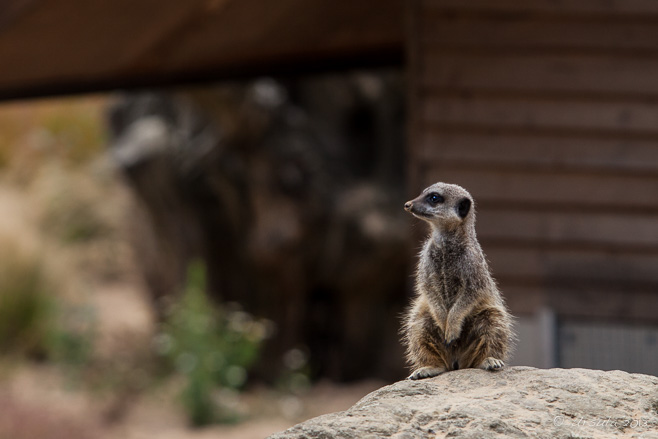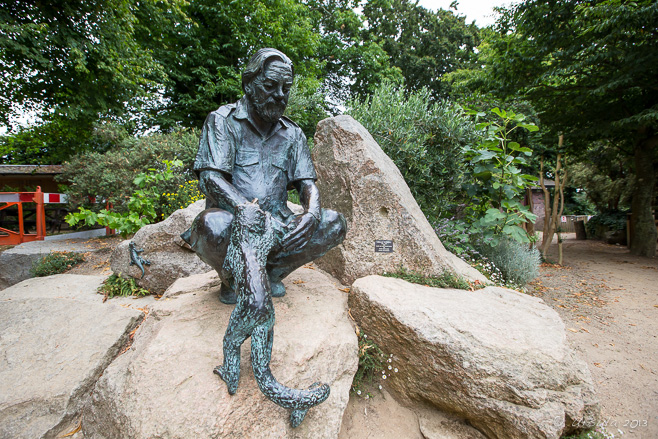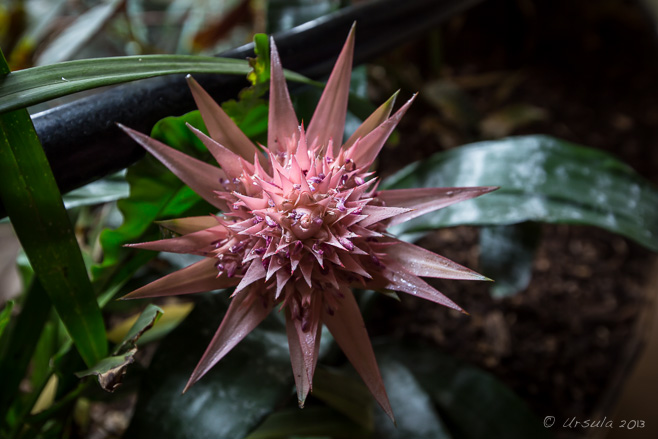
Meerkat
A meerkat sentry keeps watch at the Durrell Wildlife Park, Jersey.
“There is a pleasure in being mad which none but madmen know.”
– John Dryden, The Spanish Friar (1681)
“There is a pleasure in being mad which none but madmen know.” That is the Dryden quote that opens Gerald Durrell’s first book: My Family and Other Animals.
And an apposite quote it is!
When I first read the book as a young adult, I remember thinking how impossibly crazy was the life that the young Durrell had led in Corfu. Unreal. Like a mad, magical, fantasy world.
The house I grew up in valued discipline and order to the extent that domestic animals – let alone wild ones – were not part of the equation. My friends all had dogs, and cats, and guinea pigs and hamsters… I was heartbroken when my tenth birthday came and went without any sign of the pet rabbit I had convinced myself I was getting. I did once have a glass jar of tadpoles that my aunt had helped me catch; they mouldered and rotted in the putrefying water long before they sprouted legs. An edifying experience indeed. I stopped asking for a pet.
Durrell, on the other hand, at age 10, moved from rainy England to Corfu, with his mother and siblings, four books on natural history, a butterfly net, his dog, and a jam-jar of caterpillars. He began to collect and keep the local fauna as his pets – embarking on a lifelong love-affair with natural history.
Over his lifetime, Durrell travelled extensively and became increasingly aware of problems facing animals – particularly endangered species – in the wild. He believed that by collecting them for zoos and breeding programs, these animals could be protected from extinction until their habitats were no longer under threat. In 1958, with the proceeds from his book sales, Durrell bought Les Augrès Manor, a 17th-century house in Jersey, and turned it into a home for his extensive collection of animals from around the world. Renamed the “Jersey Zoological Park”, the zoo was opened to the public in 1959.
Now called the Durrell Wildlife Park, and run by the Durrell Wildlife Conservation Trust, the zoo is part of the larger efforts of a conservation organisation still charged with saving animal species from extinction.

Gerald Durrell (1925-1995)
A sculpture of Durrell with his lemurs sits inside the entry to the Durrell Wildlife Park.

Succulent
One of the things I like best about well-kept animal parks is that they generally include beautiful gardens.

Meerkat
In “Discovery Desert”, the ever-popular slender-tailed meerkats keep an eye on the visitors to the park.

Gorilla Mother and Infant
The Critically Endangered western lowland gorillas are a central part of the Durrell philosophy: by breeding the gentle giants in captivity, a safety net is built up against their extinction in the wild.

Female Gorilla
We watch as an older mother, who has had several young, feeds on the popcorn scattered by the keepers.

Portrait: Female Gorilla
The adults – even the females – look incredibly powerful.

Searching for Food
In the wild, gorillas forage for food. In the park, food is scattered so that the animals don’t get too lazy.

Feeding
Gorillas have a very long intestine, to help them get the most out of their limited diet in the wild.

Watching the Gorillas
As parents and children watch, keepers give their gorilla talk and scatter food into the enclosure.

Infant Gorilla
Keeping an eye on mum, this little one branches out alone.

Young Male Gorilla
The young males – or blackbacks – are kept in a separate enclosure nearby – away from the females, infants and the dominant silverback.

African Red River Hogs
It seems ironic to call these these bush pigs “river hogs” – as they live in a dry, rocky enclosure.

Playground
Nearby, other primate young make use of the climbing equipment.

Sumatran Orangutans
Like the western lowland gorillas, Sumatran Orangutans are Critically Endangered. The Durrell Wildlife Park works in conjunction with the Sumatran Orangutan Conservation Programme in Indonesia to protect these “forest people”.

Orangutan and Baby
Shortly after we got to the South-east Asian Primates area, the orangutans moved to their inside enclosure for their afternoon feed and some quiet time. Paradoxical, we were able to get closer to these magnificent creatures in the wild, in their North Sumatran home (Meet the Locals).

Lily Pond

Ring-Tailed Lemurs
Ring-Tailed Lemurs live in the forests of southern Madagascar.

Alaotran Gentle Lemur
Critically Endangered primates, the Alaotran Gentle Lemurs live in Madagascar’s wetlands.

Greater Flamingo (Phoenicopterus roseus)
In the wild, these birds are found across Europe, Africa and India.

Feeding the Flamingos

Chilean Flamingos (Phoenicopterus chilensis)

Red-billed Chough
Choughs, specialist insect-eaters, died out in Jersey over a 100 years ago. The two breeding pairs at the Park are from Cornwall.

Les Augrès Manor
Now the headquarters of the Durrell Wildlife Conservation Trust, the site of Les Augrès manor house dates back to medieval times – although most of the current building is 19th century.

“The Gerald Durrell Story”
A small museum contains memorabilia from Durrell’s life and work.

Orangutan at the Entrance / Exit
 It was wonderful to be reminded of Durrell and his books and TV programs from my youth.
It was wonderful to be reminded of Durrell and his books and TV programs from my youth.
It was also wonderful to “meet” his friends and family.
It was, however, sad to reflect that these creatures are even more at risk now than they were when he first started his collections.
‘Till next time!
Pictures: 30August2013





























.png)


[…] and animal sanctuaries (as regular visitors to these pages will know; e.g.: Potoroo Palace; Durrell Wildlife Park; The Two Tarongas; Gunung Leuser Orangutangs), so any excuse to visit a new one is fine by me. And […]
[…] for crows, Australia’s choughs were named after the European birds that they resemble (see: The Stationary Ark) but are only distantly related […]